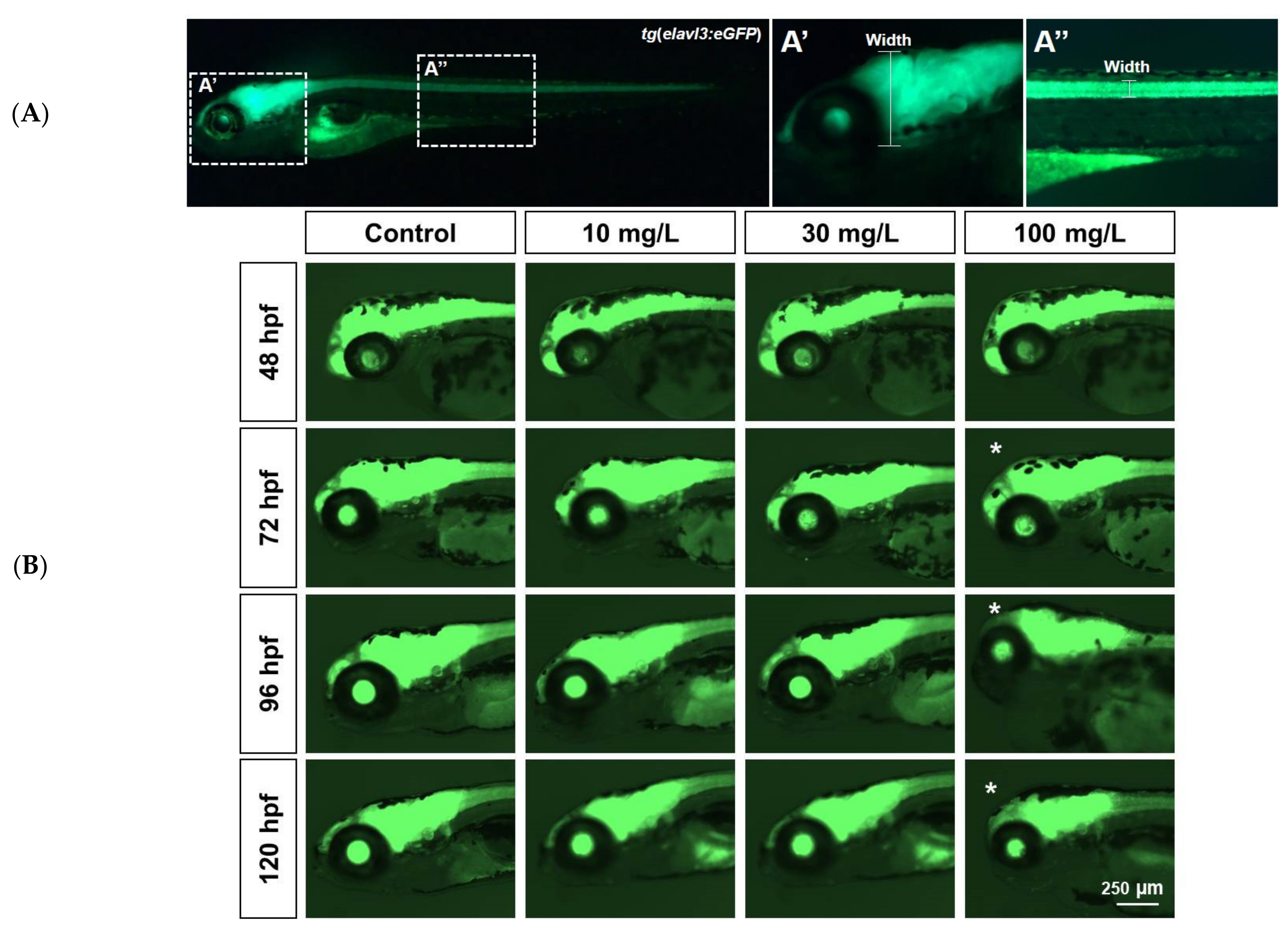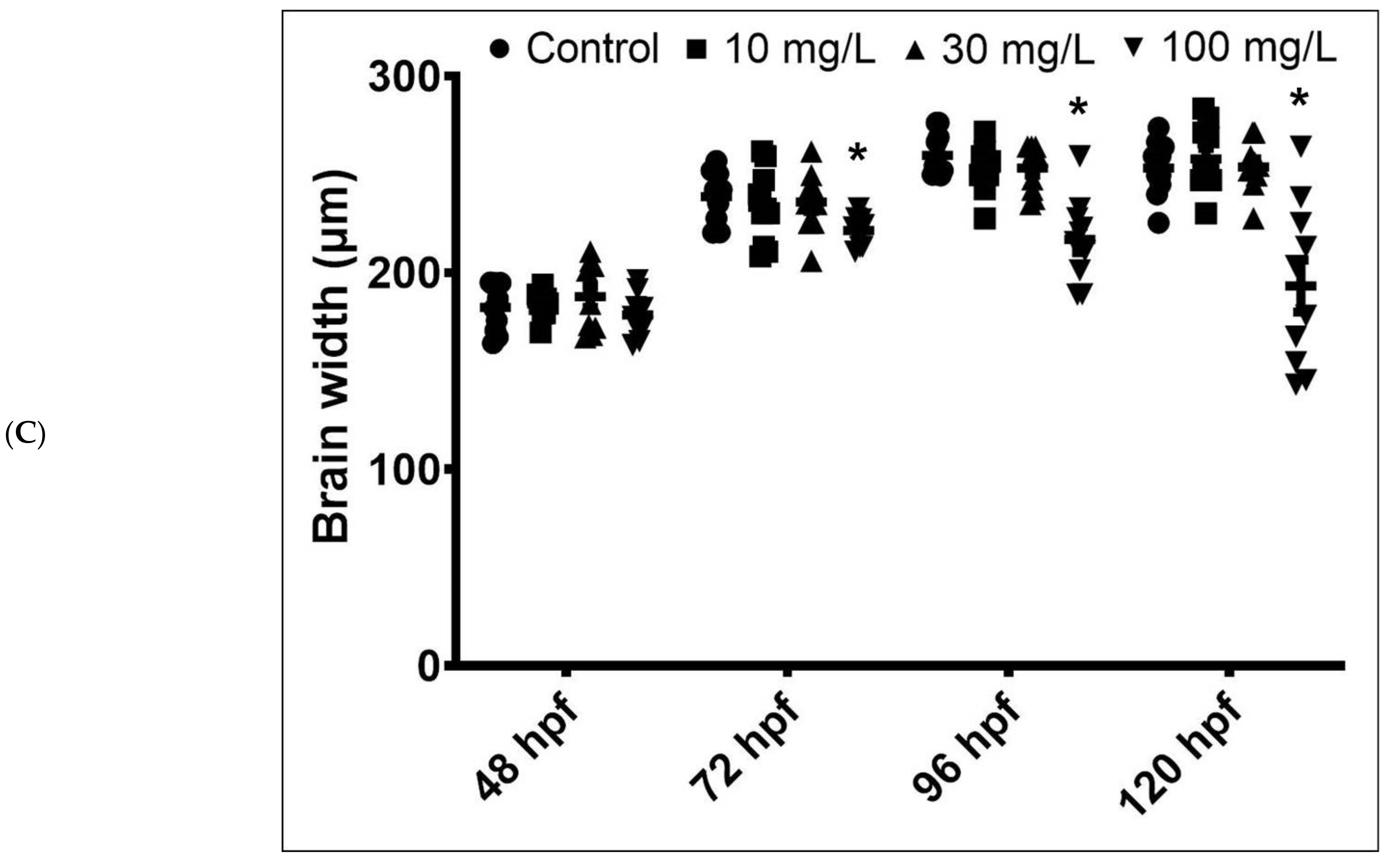Developmental and Neurotoxicity of Acrylamide to Zebrafish
Abstract
:1. Introduction
2. Results
2.1. Acrylamide-Induced Developmental Defects
2.2. Behavior
2.3. Neurotoxicity
3. Discussion
4. Materials and Methods
4.1. Animals
4.2. Acrylamide Experimental Procedure
4.3. Lethality and Developmental Toxicity
4.4. Behavior
4.5. Neurotoxicity
4.6. Statistical Analysis
Supplementary Materials
Author Contributions
Funding
Institutional Review Board Statement
Informed Consent Statement
Acknowledgments
Conflicts of Interest
References
- Seale, S.M.; Feng, Q.; Agarwal, A.K.; El-alfy, A.T. Neurobehavioral and transcriptional effects of acrylamide in juvenile rats. Pharmacol. Biochem. Behav. 2012, 101, 77–84. [Google Scholar] [CrossRef] [PubMed]
- Dasari, S.; Ganjayi, M.S.; Meriga, B. Glutathione S-transferase is a good biomarker in acrylamide induced neurotoxicity and genotoxicity. Interdiscip. Toxicol. 2018, 11, 115–121. [Google Scholar] [CrossRef] [Green Version]
- Arikawa, A.; Shiga, M. Determination of trace acrylamide in the crops by gas chromatography. Bunseki Kagaku 1980, 29, 33–39. [Google Scholar] [CrossRef]
- Al-serwi, R.H.; Ghoneim, F.M. The impact of vitamin E against acrylamide induced toxicity on skeletal muscles of adult male albino rat tongue: Light and electron microscopy study. J. Microsc. Ultrastruct. 2015, 3, 137–147. [Google Scholar] [CrossRef] [PubMed] [Green Version]
- Lehning, E.J.; Balaban, C.D.; Ross, J.F.; Lopachin, R.M. Acrylamide neuropathy III. spatiotemporal characteristics of nerve cell damage in forebrain. Neurotoxicology 2003, 24, 125–136. [Google Scholar] [CrossRef]
- Lopachin, R.M.; Decaprio, A.P. Gamma-diketone neuropathy: Axon atrophy and the role of cytoskeletal protein adduction. Toxicol. Appl. Pharmacol. 2004, 199, 20–34. [Google Scholar] [CrossRef]
- Hogervorst, J.G.F.; Baars, B.J.; Schouten, L.J.; Konings, E.J.M.; Goldbohm, R.A.; Brandt, P.A.V.D. The carcinogenicity of dietary acrylamide intake: A comparative discussion of epidemiological and experimental animal research. Crit. Rev. Toxicol. 2010, 40, 485–512. [Google Scholar] [CrossRef]
- Favor, J.; Shelby, M.D. Transmitted mutational events induced in mouse germ cells following acrylamide or glycidamide exposure. Mutat. Res. 2005, 580, 21–30. [Google Scholar] [CrossRef] [PubMed]
- Ma, Y.; Shi, J.; Zheng, M.; Liu, J.; Tian, S.; He, X.; Zhang, D.; Li, G.; Zhu, J. Toxicological effects of acrylamide on the reproductive system of weaning male rats. Toxicol. Ind. Health. 2011, 27, 617–627. [Google Scholar]
- Auld, R.B.; Bedwell, S.F. Peripheral neuropathy with sympathetic overactivity from industrial contact with acrylamide. Can. Med. Assoc. J. 1967, 96, 652–654. [Google Scholar]
- Lehning, E.J.; Balaban, C.D.; Ross, J.F.; Reid, M.A.; Lopachin, R.M. Acrylamide neuropathy I. spatiotemporal characteristics of nerve cell damage in rat cerebellum. Neurotoxicology 2002, 23, 397–414. [Google Scholar] [CrossRef]
- Lopachin, R.M.; Balaban, C.D.; Ross, J.F. Acrylamide axonopathy revisited. Toxicol. Appl. Pharmacol. 2003, 188, 135–153. [Google Scholar] [CrossRef]
- Lopachin, R.M.; Gavin, T. Molecular mechanism of acrylamide neurotoxicity: Lessons learned from organic chemistry. Environ. Health Perspect. 2012, 120, 1650–1657. [Google Scholar] [CrossRef] [Green Version]
- Field, E.A.; Price, C.J.; Sleet, R.B.; Marr, M.C.; Schwetz, B.A.; Morrissey, R.E. Developmental toxicity evaluation of acrylamide in rats and mice. Fundam. Appl. Toxicol. 1990, 14, 502–512. [Google Scholar] [CrossRef]
- Zhu, F.; Wang, J.; Jiao, J.; Zhang, Y. Exposure to acrylamide induces skeletal developmental toxicity in zebrafish and rat embryos. Environ. Pollut. 2021, 271, 1–10. [Google Scholar] [CrossRef]
- Vesterlund, L.; Jiao, H.; Unneberg, P.; Hovatta, O.; Kere, J. The zebrafish transcriptome during early development. BMC Dev. Biol. 2011, 11, 1–18. [Google Scholar] [CrossRef] [Green Version]
- Xia, Q.; Wei, L.; Zhang, Y.; Kong, H.; Shi, Y.; Wang, X.; Chen, X.; Han, L.; Liu, K. Psoralen induces developmental toxicity in zebrafish embryos / larvae through oxidative stress, apoptosis, and energy metabolism disorder. Front. Pharmacol. 2018, 9, 1–12. [Google Scholar] [CrossRef]
- Prats, E.; Gómez-Canela, C.; Ben-Lulu, S.; Ziv, T.; Padrós, F.; Tornero, D.; Garcia-Reyero, N.; Tauler, R.; Admon, A.; Raldúa, D. Modelling acrylamide acute neurotoxicity in zebrafish larvae. Sci. Rep. 2017, 7, 1–12. [Google Scholar] [CrossRef] [PubMed] [Green Version]
- Kalueff, A.V.; Echevarria, D.J.; Homechaudhuri, S.; Stewart, A.M.; Collier, A.D.; Kaluyeva, A.A.; Li, S.; Liu, Y.; Chen, P.; Wang, J.; et al. Zebrafish neurobehavioral phenomics for aquatic neuropharmacology and toxicology research. Aquat. Toxicol. 2016, 170, 297–309. [Google Scholar] [CrossRef] [PubMed]
- Howe, K.; Clark, M.D.; Torroja, C.F.; Torrance, J.; Berthelot, C.; Muffato, M.; Collins, J.E.; Humphray, S.; McLaren, K.; Matthews, L.; et al. The zebrafish reference genome sequence and its relationship to the human genome. Nature 2013, 496, 498–503. [Google Scholar] [CrossRef] [PubMed] [Green Version]
- Babin, P.J.; Goizet, C.; Raldu, D. Zebrafish models of human motor neuron diseases: Advantages and limitations. Prog. Neurobiol. 2014, 118, 36–58. [Google Scholar] [CrossRef]
- Faria, M.; Garcia-Reyero, N.; Padrós, F.; Babin, P.J.; Sebastián, D.; Cachot, J.; Prats, E.; Arick Ii, M.; Rial, E.; Knoll-Gellida, A.; et al. Zebrafish models for human acute organophosphorus poisoning. Sci. Rep. 2015, 5, 1–15. [Google Scholar] [CrossRef] [PubMed] [Green Version]
- Horzmann, K.A.; Freeman, J.L. Zebrafish get connected: Investigating neurotransmission targets and alterations in chemical toxicity. Toxics 2016, 4, 19. [Google Scholar] [CrossRef] [PubMed] [Green Version]
- Huang, M.; Jiao, J.; Wang, J.; Xia, Z.; Zhang, Y. Characterization of acrylamide-induced oxidative stress and cardiovascular toxicity in zebrafish embryos. J. Hazard. Mater. 2018, 347, 451–460. [Google Scholar] [CrossRef] [PubMed]
- Qian, L.; Cui, F.; Yang, Y.; Liu, Y.; Qi, S.; Wang, C. Mechanisms of developmental toxicity in zebrafish embryos (Danio rerio) induced by boscalid. Sci. Total Environ. 2018, 634, 478–487. [Google Scholar] [CrossRef]
- Faria, M.; Ziv, T.; Gómez-Canela, C.; Ben-Lulu, S.; Prats, E.; Novoa-Luna, K.A.; Admon, A.; Piña, B.; Tauler, R.; Gómez-Oliván, L.M.; et al. Acrylamide acute neurotoxicity in adult zebrafish. Sci. Rep. 2018, 8, 1–14. [Google Scholar] [CrossRef]
- Faria, M.; Valls, A.; Prats, E.; Bedrossiantz, J.; Orozco, M.; Porta, J.M.; Gómez-Oliván, L.M.; Raldúa, D. Further characterization of the zebrafish model of acrylamide acute neurotoxicity: Gait abnormalities and oxidative stress. Sci. Rep. 2019, 1, 1–7. [Google Scholar] [CrossRef] [Green Version]
- Lebda, M.A.; Gad, S.B.; Rashed, R.R. The effect of lipoic acid on acrylamide-induced neuropathy in rats with reference to biochemical, hematological, and behavioral alterations. Pharm. Biol. 2015, 8, 1207–1213. [Google Scholar] [CrossRef]
- Belhadj Benziane, A.; Dilmi Bouras, A.; Mezaini, A.; Belhadri, A.; Benali, M. Effect of oral exposure to acrylamide on biochemical and hematologic parameters in Wistar rat. Drug Chem. Toxicol. 2019, 42, 157–166. [Google Scholar] [CrossRef]
- de Esch, C.; Slieker, R.; Wolterbeek, A.; Woutersen, R.; de Groot, D. Zebrafish as potential model for developmental neurotoxicity testing: A mini review. Neurotoxicol. Teratol. 2012, 34, 545–553. [Google Scholar] [CrossRef]
- Lee, J.; Freeman, J.L. Zebrafish as a model for investigating developmental lead (Pb) neurotoxicity as a risk factor in adult neurodegenerative disease: A mini-review. Neurotoxicology 2014, 43, 57–64. [Google Scholar] [CrossRef]
- Mcgrath, P.; Li, C.Q. Zebrafish: A predictive model for assessing drug-induced toxicity. Drug Discov. Today. 2008, 13, 394–401. [Google Scholar] [CrossRef]
- Adler, I.; Schmer, R. Dose response for heritable translocations induced by acrylamide in spermatids of mice. Mutat. Res. 1994, 309, 285–291. [Google Scholar] [CrossRef]
- Tyla, R.W.; Friedman, M.A.; Losco, P.E.; Fisher, L.C.; Johnson, K.A.; Strother, D.E.; Wolf, C.H. Rat two-generation reproduction and dominant lethal study of acrylamide in drinking water. Reprod. Toxicol. 2000, 14, 385–401. [Google Scholar] [CrossRef]
- USEPA. Toxicology Review of Acrylamide (CAS No. 79-06-1); U.S. Environmental Protection Agency: Washington, DC, USA, 2004; pp. 1–459.
- Spencer, H.; Wahome, J.; Haasch, M. Toxicity evaluation of acrylamide on the early life stages of the zebrafish embryos (Danio rerio). J. Environ. Protection. 2018, 9, 1082–1091. [Google Scholar] [CrossRef] [Green Version]
- Asakawa, K.; Abe, G.; Kawakami, K.; Baier, H. Cellular dissection of the spinal cord motor column by BAC transgenesis and gene trapping in zebrafish. Front. Neural Circuits 2013, 7, 1–14. [Google Scholar] [CrossRef] [PubMed] [Green Version]
- Pennisi, M.; Malaguarnera, G.; Puglisi, V.; Vinciguerra, L. Neurotoxicity of acrylamide in exposed workers. Int. J. Environ. Res. Public Health 2013, 10, 3843. [Google Scholar] [CrossRef] [PubMed] [Green Version]
- Lopachin, R.M.; He, D.; Reid, M.L.; Opanashuk, L.A. 2,5-hexanedione-induced changes in the monomeric neurofilament protein content of rat spinal cord fractions. Toxicol. Appl. Pharmacol. 2004, 198, 61–73. [Google Scholar] [CrossRef]
- Tian, S.M.; Ma, Y.X.; Shi, J.; Lou, T.Y.; Liu, S.S.; Li, G.Y. Acrylamide neurotoxicity on the cerebrum of weaning rats. Neural Regen. Res. 2015, 10, 938–943. [Google Scholar]
- Kandhare, A.D.; Mukherjee, A.A.; Bodhankar, S.L. Neuroprotective effect of azadirachta indica standardized extract in partial sciatic nerve injury in rats: Evidence from anti-inflammatory, antioxidant and anti-apoptotic studies. EXCLI J. 2017, 16, 546–565. [Google Scholar] [PubMed]
- Aziz, I.; Che Ramli, M.D.; Mohd Zain, N.S.; Sanusi, J. Behavioral and histopathological study of changes in spinal cord injured rats supplemented with spirulina platensis. Evid. Based Complement. Alternat. Med. 2014, 2014, 1–9. [Google Scholar] [CrossRef] [PubMed] [Green Version]
- Zhang, Z.; Fujiki, M.; Guth, L.; Steward, O. Genetic influences on cellular reactions to spinal cord injury: A wound-healing response present in normal mice is impaired in mice carrying a mutation (Wlds) that causes delayed wallerian degeneration. J. Comp. Neurol. 1996, 371, 485–495. [Google Scholar] [CrossRef]








Publisher’s Note: MDPI stays neutral with regard to jurisdictional claims in published maps and institutional affiliations. |
© 2021 by the authors. Licensee MDPI, Basel, Switzerland. This article is an open access article distributed under the terms and conditions of the Creative Commons Attribution (CC BY) license (http://creativecommons.org/licenses/by/4.0/).
Share and Cite
Park, J.-S.; Samanta, P.; Lee, S.; Lee, J.; Cho, J.-W.; Chun, H.-S.; Yoon, S.; Kim, W.-K. Developmental and Neurotoxicity of Acrylamide to Zebrafish. Int. J. Mol. Sci. 2021, 22, 3518. https://doi.org/10.3390/ijms22073518
Park J-S, Samanta P, Lee S, Lee J, Cho J-W, Chun H-S, Yoon S, Kim W-K. Developmental and Neurotoxicity of Acrylamide to Zebrafish. International Journal of Molecular Sciences. 2021; 22(7):3518. https://doi.org/10.3390/ijms22073518
Chicago/Turabian StylePark, Jong-Su, Palas Samanta, Sangwoo Lee, Jieon Lee, Jae-Woo Cho, Hang-Suk Chun, Seokjoo Yoon, and Woo-Keun Kim. 2021. "Developmental and Neurotoxicity of Acrylamide to Zebrafish" International Journal of Molecular Sciences 22, no. 7: 3518. https://doi.org/10.3390/ijms22073518






